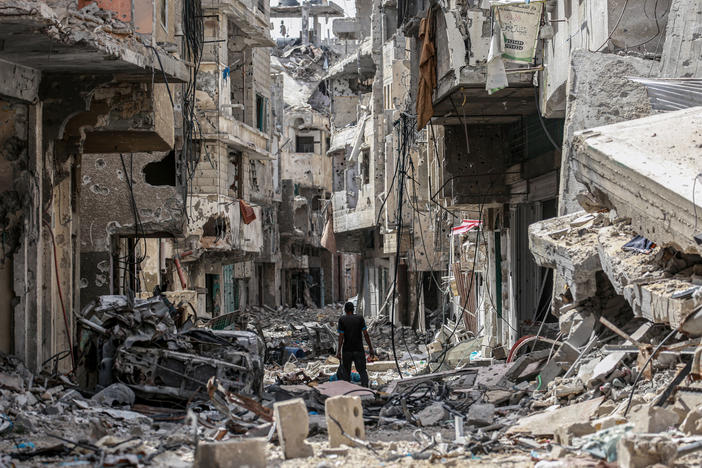Section Branding
Header Content
Israel has agreed to a daily 'humanitarian corridor.' What does this mean?
Primary Content
Updated November 10, 2023 at 12:06 PM ET
TEL AVIV, Israel — Israel has agreed to allow civilians stuck in northern Gaza time to move safely to areas in the south for several hours each day, the White House announced.
This ostensibly will also allow more aid to reach Palestinians in Gaza, National Security Council spokesperson John Kirby told reporters Thursday.
Going forward, there will be an announcement made three hours before each pause, Kirby said.
Israel is referring to this as a humanitarian corridor.
"Israel has an obligation to fully comply with international law, and we believe these pauses are a step in the right direction, particularly to help ensure that civilians have an opportunity to reach safer areas away from the act of fighting," Kirby said Thursday.
While Israel gave Palestinians six hours on Friday to make it to Gaza's designated safe route, civilians to the north reported that dozens of people were killed in airstrikes around multiple hospitals.
U.N. human rights commissioner calls safe zones "alarming"
Periods to allow for safe evacuations stem from recent discussions between U.S. and Israeli officials.
But the agreement — the framework of which is not new — shouldn't be mistaken for a longer-term cease-fire or humanitarian pause. Israel has already held four- or five-hour pauses several times in the past week. Tens of thousands of Palestinians have managed to use them to head to southern Gaza.
More than 50,000 civilians in Gaza used the "humanitarian corridor" on Thursday, IDF spokesperson Rear Adm. Daniel Hagari said at a press briefing Thursday.
Israel also hasn't committed to pausing airstrikes — rather, they agreed to avoid certain areas during this break.
The United Nations High Commissioner for Human Rights Volker Türk criticized such a move.
"Demands for civilians to relocate to an Israeli Defence Force designated 'safe zone' are also very alarming. A so-called 'safe zone,' when established unilaterally, can heighten risks to civilians, and raises real questions as to whether security can be guaranteed in practice," Türk said in news conference in Amman, Jordan. "At the moment, nowhere in Gaza is safe, as bombardments are being reported in all parts of the Strip. It also needs to be absolutely clear that civilians are protected under international law wherever they are."
He repeated a demand for a cease-fire, as many humanitarian groups have done in recent weeks.
Establishing a longer humanitarian pause or even a cease-fire is the subject of several ongoing talks over the release of hostages between U.S. officials and leaders in the Middle East.
CIA chief William Burns and leaders of Mossad, Israel's intelligence agency, met with the Qatari prime minister in Doha Thursday to discuss a deal for releasing the some 240 hostages kidnapped one month ago, according to Reuters.
Meanwhile, in Egypt on Friday morning, President Abdel Fattah El-Sisi welcomed the Qatar emir, Sheikh Tamim bin Hamad Al Thani, at the Cairo International Airport.
Qatar continues to play a major role in talks to release hostages as it holds the best position to influence Hamas on this issue.
An estimated 240 people were kidnapped by Hamas on Oct. 7.
Around 1,400 people in Israel were killed when Hamas attacked more than a month ago. More than 11,000 Palestinians have been killed in Gaza since this war began, according to new data released Friday by health officials in the Hamas-run territory.
Hospitals continue to face impact of Israeli airstrikes
Overnight, reports from hospitals, aid groups and witnesses on the ground said multiple hospitals had been hit by and suffered damage from Israeli airstrikes.
A video posted on social media from a witness in said that Al Rantisi hospital was being surrounded by Israeli tanks and that people were being ordered to leave without the assistance of humanitarian groups, such as the Red Cross, to ensure safety.
Overnight ten employees of Al Awda Hospital, in the north of Gaza, were injured and some departments at the hospital were severely damaged after airstrikes targeted the area surrounding the medical facility, according to the Al Awda Health and Community Association.
A video shared by the hospital shows the staff cleaning debris from the streets and entrances just outside of the hospital after airstrikes hit the area overnight. The clip also showed severely damaged ambulances. Al Awda Health and Community Association said that at least two ambulances and at least nine other vehicles were damaged or completely destroyed in the attacks.
Several videos also shared overnight showed people injured at a facility that is part of the Al-Shifa Hopsital in Gaza City. It's the largest hospital in Gaza, and has been a shelter for the displaced and injured since the Israeli incursion began.
Just a week ago, an Israeli airstrike just outside that hospital killed more than a dozen people. Israel said it targeted Hamas members.
The Israeli military maintains it has not directly targeted a hospital, but the health officials in Gaza say the Al-Shifa Medical Complex in the north has been a target for Israeli military airstrikes five times.
"Strikes on hospitals and in the vicinity of hospitals in Gaza City have been particularly intense, especially around the two biggest hospitals in the area — Indonesia hospital in Beit Lahiya and Al Shifa hospital in Gaza City. Meanwhile, the strikes on surrounding areas render access to hospitals difficult, including by destroying roads," said Türk, the U.N.'s High Commissioner for Human Rights.
"Some hospitals, including Al Quds and Al Shifa hospitals have also received specific evacuation orders, in addition to the general evacuation orders to all of northern residents of Gaza," he said in his speech in Jordan. "But such evacuation, as the World Health Organization has warned, is a 'death sentence' in a context where the entire medical system is collapsing and hospitals in southern Gaza have no capacity to absorb more patients."
Copyright 2023 NPR. To see more, visit https://www.npr.org.
Bottom Content






